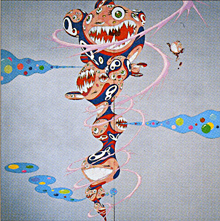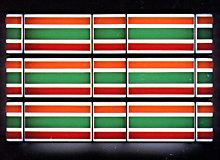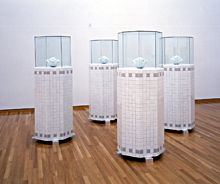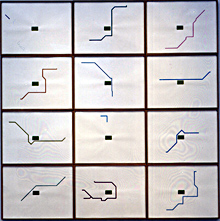6c
東京シミュレーショニズム(1)村上隆と中村政人
Tokyo Simulationism (1) Takashi Murakami and Masato Nakamura
【本文確定】
「パロディ・贋作」の終了直後、東京藝術大学大学院修士後期課程に在籍していた村上隆が、私の家を訪ねてきました。中村信夫の『少年アート』と私の『近代美術史テキスト』を大変重要だと大声で語りました。私は『少年アート』に対するアンチとして『近代美術史テキスト』を書いたので何か言ったはずですが、覚えていません。以後彼からは、細かい手書き文字でびっしり埋められたファクスが、深夜や早朝に頻繁に送られてくるようになりました。『アート三文ネタニュース(A.G.N.)』と題されたそれは美術界周りの事項が彼の視点からエネルギッシュに語られた内容で、評論家やプレス関係を含む彼の知人たちに配信されていました*6c1。
村上隆の「ポリリズム」は米軍歩兵模型が可動式パネルにびっしり取りつけられた作品、「ランドセル・プロジェクト」はワシントン条約で取引が禁止されている稀少動物の皮で作られたランドセルでした。1991年から始められた制作と立て続けに行われた彼の個展では、コンセプトをそのまま見せているかのような武骨な作品の佇まいと、神主やファッションモデルを起用した美術展らしからぬオープニング・ショーに、毎回大人数が動員されました。日本のバブル経済は崩壊しましたが、美術界での異変がまさに進行中でした。
この時期にはほかにも、ポストもの派やBゼミ系とは全く違った、「コンセプトありき」の強靱な美術が出現していました。柳幸典、太郎千恵藏、笠原恵実子、福田美蘭、豊嶋康子、飴屋法水らです。しかしここでは周囲を巻き込み一丸となって出ていった村上隆、中村政人、小沢剛、会田誠らを記します。4名とも東京藝術大学出身で、周囲もほとんど同世代でした*6c2。
村上隆のアルバイト仲間だった中村政人は*6c3、韓国政府の招待奨学生として、ソウルの弘益大学大学院に留学中でした。日本の韓国統治時代の記憶から、当地で最も不快な印象を与える日本姓が中村と村上であることを知り、自身と村上隆の二人展「中村と村上」を構想、1992年7月にソウル展をスペース・オゾンで行いました。そのときゲストとして呼ばれた舞踏家の池宮中夫は、敢えて(日本からの)独立記念公園で街頭パフォーマンスを行い、記念碑を長時間睨みつけたり、突然街路灯によじ登ったりして市民たちの顰蹙を買いました。同行した世話人は、当時は白石コンテンポラリーアート(SCAI)の社員だった小山登美夫と、グループのブレーンで美術ジャーナリストの西原珉でした。そして世界中ですでにジゾイング(地蔵建立)を開始していた小沢剛、膨大な未発表作品群を抱えていた会田誠が随行し、申明銀、イベント企画の国持貴子、そして私も、オブザーバーとして一行に加わっていました。
続く1992年8月には「中村と村上」東京展が、青山に当時あったSCAIで行われました。ソウル展の時と同様、中村の「トコヤマーク」がビル屋上に設置され、同じシニフィアンが両国で異なるシニフィエをもつ図式を燦然と夜空に輝かせました*6c4。
1992年9月には、レントゲン藝術研究所で椹木野衣のキュレーションによる伝説の展覧会「アノーマリー」が開催されました。レントゲン藝術研究所は倉庫を改造して1991年6月に東京大森にオープンした3階建ての大空間で、活気づいた東京の新動向を一手に引き受け、村上隆の個展や、多くのワンナイトエキジビションをすでに実施していました。「アノーマリー」は参加者4名のバトル方式のグループ展で、関西の中原浩大、ヤノベケンジと、東京の村上隆、伊藤ガビンが激突しました。初日には400人以上が詰めかけ、オーナーの池内務はメガホンで客を仕切りました。かねてから関西勢、特に中原浩大との対決を意識していた村上隆は*6c5、圧倒的な量の光を発する「シーブリーズ」を出品、シャッターが上がると観客は眩しさと日焼けを避け3階へ避難しました*6c6。ところがそこでは車輪が取り外された伊藤ガビンの「純粋バイク」にアクセルがかけられ、轟音が鳴り響き排気ガスが充満しました*6c7。そして西原珉、小山登美夫、村上隆による伝説的な現代美術愛好誌『アートサミットメンバーズ』がこの日にあわせて刊行され、小沢剛や、実験テレビカンパニー(八谷和彦と松尾ハルユキのユニット)ほかによる飛び入りハプニングが相次ぎ、建物入口には霊柩車が横付けされました。
同じ1992年9月、東京渋谷のシードホールで行われたグループ展「TAMA VIVANT ’92」のオープニングでは、村上隆は初めて自身でパフォーマンスを行いました。「村上佐保太郎左衛門隆之介の紙やぶり」と題された、具体の村上三郎の「紙やぶり」の再現で、「村上三郎と同じ村上だから」と大声で彼は笑いましたが、これが続く「再現芸術」の端緒となりました。
1992年12月、「中村と村上」大阪展がメタリアスクエアという名の巨大ラブホテルで開催されました。初日の12月4日には、再現芸術集団「スモールヴィレッジセンター」による「大阪ミキサー計画」が行われました。発想は、大阪の青井画廊で個展開催中の小沢剛とコラボレートしたいと村上隆が考え、中村政人の名を足せば「小沢、村上、中村」の頭文字「小」「村」「中」からスモールヴィレッジセンターが名乗れることでした。ハイレッド・センターのパロディです。すぐに私(「中」ザワ)も加わりましたが、中村政人はその構成員であるというつもりは最初からありませんでした*6c8。
「大阪ミキサー計画」では、ハイレッド・センターの「首都圏清掃整理促進運動」を大阪梅田地下街で再現し、続けて「山手線事件」を大阪環状線で再現する計画でした。しかし実際には前者の「大阪清掃計画」のみ実施され*6c9、その記録画像は4日後の12月8日に行われたワンナイト・パーティーに合わせて創刊された日本初のフロッピーディスク・マガジン『Japan Art Today』第1号に収録されました。発行メンバーは京都を拠点とする美術ライターの原久子、美大生の吉田裕子、東京の私でした*6c10。
「中村と村上」大阪展の会期中は前述の「大阪ミキサー計画」やワンナイト・パーティーのほか、池宮中夫の路上パフォーマンス「ヒロポン」、村上隆の「グランド・オベリスク」(イヴ・クライン「青のオベリスク」の白光による再現)、村上隆の「クラインジャンプ」(イヴ・クライン「空中飛翔する芸術家」の大阪道頓堀における再現)等、多数のイベントが次々と行われ、東京勢が総出で大阪に集結し、関西アートシーンに攻勢をかけた図式となりました。
Murakami Takashi, who was in the last part of the masters course at the graduate school of Tokyo National University of Fine Arts and Music, came to see me right after my exhibition, "Parody / Counterfeit," was finished. He said in a loud voice that Nakamura Nobuo's "Shonen Art" and my "Text on Modern Art History" were both very important to him. I don't remember now what I said to him in spite of that I had said something because I intentionally wrote "Text on Modern Art History" to present my opposition to "Shonen Art." Since then, his hand written newsletters full of small characters were frequently to be faxed during midnights and in early mornings. In the newsletters he energetically talked about things about art, and these newsletters were also sent to his acquaintances including art critics and media circles*6c1.
Murakami's work, "Polyrhythm," in which U.S. infantryman models were closely installed on a mobile panel and his other work, "Schoolchildren's Satchel Project (Ransel Project)," which consisted of eight school satchels made from skins of precious animals that the Washington Convention prohibits trading. Through his production activities and a series of his many exhibitions which began in 1991, rough appearance of his works which intentionally revealed the naked concept and the opening shows in which a Shinto priest and fashion models participated unlikely to an art exhibition of its kind drew so many spectators each time. Although the Japanese bubble economy had collapsed, something unusual was going on right inside of the art world at that time.
During this period, tough art carrying a banner of "Concept must come first" appeared which was completely different from Post Mono-ha and B Seminar Schooling System type. Artists of this category are Yanagi Yukinori, Taro Chiezo, Kasahara Emiko, Fukuda Miran, Toyoshima Yasuko and Ameya Norimizu. However, in this section I would like to introduce Murakami Takashi, Nakamura Masato, Ozawa Tsuyoshi and Aida Makoto who involved people around them and debuted in solidarity. Those four artists were all graduates of Tokyo National University of Fine Arts and Music, and most of those around them belonged to the same generation*6c2.
Nakamura Masato, who was Murakami's part time job friend*6c3, was studying at Hongik University in Seoul, Korea, as an invitation scholarship student of the Korean government at that time. As he came to realize that the names Nakamura and Murakami reminded Korean people of unpleasant memory of the Japanese occupation most among many Japanese family names, Nakamura made a plan to have a two person exhibition, "Nakamura and Murakami," and eventually the exhibition in Seoul was held at Space Ozone in July 1992. Ikemiya Nakao, a dancer who was invited as a guest at the exhibition, performed a street performance daringly in the Independence Commemorative Park, scowling at the monument for a long time and suddenly climbing up a street light. He was frowned upon by people in Seoul. Those who accompanied with the artists were Koyama Tomio, an employee of Shiraishi Contemporary Art (SCAI) at that time, and Nishihara Min, an advisor to the group and art journalist. There were other people who participated in this group such as Ozawa Tusyoshi, who was already active in Jizo-ing overseas, Aida Makoto, who had a large number of unpublished works, Shin Myeong Eun, Kunimochi Takako of the event planning, and also myself as an observer.
In August of the same year, the "Nakamura and Murakami Exhibition" in Tokyo was held at the SCAI, which was in Aoyama at that time. The "Sign for a Barbershop" was installed on the top of the building just like in the exhibition in Seoul, and the same signifiant shared by the two countries made a diagram brighten in the night sky, though both had different signifie*6c4.
In September, the legendary exhibition, "Anomaly," was held at Ikeuchi Tsutomu's Roentgen Kunst Institut under the curatorship of Sawaragi Noi. The Roentgen Kunst Institut was a remodeled warehouse and opened in Omori, Tokyo, in June of the previous year. The three story building had a large space that enabled it to take care of new art activities of lively Tokyo. It had already proved its capability when it held Murakami's exhibition and his one-night exhibition. "Anomaly" was a type of exhibition in which four participants aggressively compete. In this competition, Nakahara Kodai and Yanobe Kenji from Kansai and Murakami Takashi and Ito Gabin of Tokyo clashed. On the first day, 400 spectators crowded into the space and Ikeuchi had to guide them with a megaphone. Murakami, who had been eager to compete against the Kansai group, especially Nakahara for some time*6c5, displayed work of an overwhelmingly bright lightning, "Sea Breeze." When the shutter was lifted, the spectators had to flee to the third floor avoiding the dazzling brightness and sunburn*6c6. However, they found the third floor thundering with noise and full of fumes from the accelerated engine of Ito's "Pure Bike" without wheels*6c7. Furthermore, Nishihara, Koyama and Murakami scheduled the legendary contemporary art magazine, "Art Summit Members" to appear on the market on the same day as this event. There were many happenings at this exhibition such as an unexpected participation by Ozawa Tsuyoshi and the "Experimental Television Company," a pair unit by Hachiya Kazuhiko and Matsuo Haruyuki. A hearse was even brought to the entrance of the building.
In the same month, Murakami gave a performance by himself for the first time at the opening of the group exhibition "TAMA VIVANT '92" held at the Seed Hall in Shibuya, Tokyo. He named the performance "Breaking Paper by Murakami Sahotaro Saemon Ryunosuke." His performance was to reproduce "Paper Breaking" by Murakami Saburo with Gutai, and he had a hearty laugh saying, "Because my name Murakami is the same as Murakami Saburo's." This performance was the beginning of a series of "reproductive art."
In December, the "Nakamura and Murakami Exhibition" in Osaka was held at a huge love hotel, Metalia Square. On the opening day on December 4th, the reproductive art group, "Small Village Center," performed the "Osaka Mixer Plan." The idea of this performance was Murakami's who wished to collaborate with Ozawa Tsuyoshi, who was just holding his solo show at Aoi Gallery in Osaka at that time. He thought that taking the first kanji character from Ozawa, Murakami and Nakamura and putting them together would make "Small Village Center" in English (O-Small, Mura-Village, Naka-Center). It was a parody of Hi-red Center. I, "Naka"-zawa, immediately joined the group, but Nakamura had no intention to become a member from the beginning*6c8.
In the Osaka Mixer Plan, we had a plan to reproduce the "Movement to Promote the Cleanup of the Metropolitan Area," performed by Hi-red Center, in the Osaka-Umeda underground shopping center and to perform a reproduction of the "Yamanote Line Incident" as the Osaka Kanjosen version. However, the former "Osaka Cleaning Plan" was actually the only performance carried out in this project*6c9. The performance was recorded on floppy disks in the first issue of "Japan Art Today," the first floppy disk magazine in Japan published on the same day as the one night party which was held four days after the performance. The editors of the magazine were Hara Hisako, an art writer working in Kyoto, Yoshida Hiroko, an art college student, and myself from Tokyo*6c10.
During the exhibition period, many performances took place, e.g. "Hiropon" performed in the street by Ikemiya, "Grand Obelisk" which was a reproduction of Yves Kline's "Blue Obelisk" done by Murakami who used white light to light up the Metalia Square from the ground, also Murakami's "Kline Jump in Dotombori, Osaka" which was a reproduction of the "Flying Artist," and many other events. It was a big showing off by the Tokyo artists and those around gathered in Osaka against the Kansai art scene.




